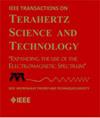Application of Multipass Cell Compression to Achieve High Repetition Rate Lithium Niobate Terahertz Sources With Broadened Bandwidth
IF 3.9
2区 工程技术
Q2 ENGINEERING, ELECTRICAL & ELECTRONIC
IEEE Transactions on Terahertz Science and Technology
Pub Date : 2025-04-28
DOI:10.1109/TTHZ.2025.3564709
引用次数: 0
Abstract
The performance of high-repetition-rate (e.g., MHz) 1030-nm-pumped lithium niobate (LiNbO3) terahertz (THz) source is significantly influenced by pulse duration, intensity, and pump wavelength. In this study, we present the application of single-stage multipass cell (MPC) compression technology to compress 1030 nm laser pulses from 200 to 49 fs and investigate its impact on THz emission using the tilted pulse front method. The results show that the compressed 49 fs pulses significantly broaden the THz spectral bandwidth, shifting the center frequency from 0.5 to 0.84 THz and extending the cutoff frequency to 4.1 THz. Although shorter pulses have lower conversion efficiency compared with longer pulses (e.g., 200 fs), they generate a broader THz spectrum. This bandwidth improvement addresses the critical limitations of narrow bandwidth and low temporal resolution in current LiNbO3-based THz scanning tunneling microscopy (THz-STM) systems. By increasing the THz bandwidth, we provide an efficient approach to achieve better temporal resolution and more affluent spectral information in THz-STM systems. This study demonstrates the potential of MPC compression technology to significantly enhance THz bandwidth in LiNbO3 crystals, paving the way for more accurate material analysis, imaging, and characterization using THz-STM.多通单元压缩在实现高重复率铌酸锂太赫兹源宽频带中的应用
高重复率(如MHz) 1030nm泵浦铌酸锂(LiNbO3)太赫兹(THz)源的性能受脉冲持续时间、强度和泵浦波长的显著影响。在这项研究中,我们提出了应用单级多通单元(MPC)压缩技术将1030nm激光脉冲从200到49 fs压缩,并使用倾斜脉冲前方法研究其对太赫兹发射的影响。结果表明,压缩后的49fs脉冲显著拓宽了太赫兹频谱带宽,中心频率从0.5 THz移动到0.84 THz,截止频率延长到4.1 THz。虽然较短脉冲的转换效率低于较长的脉冲(例如,200fs),但它们产生更宽的太赫兹频谱。这种带宽改进解决了当前基于linbo3的太赫兹扫描隧道显微镜(THz- stm)系统中窄带宽和低时间分辨率的关键限制。通过增加太赫兹带宽,我们提供了一种在太赫兹- stm系统中实现更好的时间分辨率和更丰富的频谱信息的有效方法。这项研究证明了MPC压缩技术显著提高LiNbO3晶体太赫兹带宽的潜力,为使用太赫兹stm进行更准确的材料分析、成像和表征铺平了道路。
本文章由计算机程序翻译,如有差异,请以英文原文为准。
求助全文
约1分钟内获得全文
求助全文
来源期刊

IEEE Transactions on Terahertz Science and Technology
ENGINEERING, ELECTRICAL & ELECTRONIC-OPTICS
CiteScore
7.10
自引率
9.40%
发文量
102
期刊介绍:
IEEE Transactions on Terahertz Science and Technology focuses on original research on Terahertz theory, techniques, and applications as they relate to components, devices, circuits, and systems involving the generation, transmission, and detection of Terahertz waves.
 求助内容:
求助内容: 应助结果提醒方式:
应助结果提醒方式:


